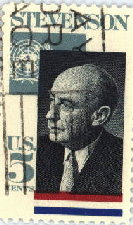New Nations Emerge In Africa
Across the Atlantic from South America, the peoples of
Africa were joining the world family of nations. Starting with
Sudan; Morocco and Tunisia in 1956 and Ghana in 1957, 30
African nations had won their independence by the end of 1963.
U.S. leaders welcomed these new nations, whose emergence from
colonial status seemed to recall America's own past. The U.S.
Ambassador to the United Nations under President Kennedy,
Adlai E. Stevenson, predicted an increasingly important role for
the new African states in the world forum.

One of Stevenson's first acts was to cast the U.S. vote in support of an African-sponsored proposal calling for a U.N. investigation of racial disorders in the Portuguese colony of Angola in Africa. Both publicly and privately, the United States urged Portugal to accept self-determination for its African territories. Ambassador Stevenson also called for an end to the apartheid policy of the Republic of South Africa and supported a U.N. resolution asking member nations not to sell or ship arms to that country.
Eruption of civil strife in the Republic of the Congo, after it had won its independence from Belgium in 1960, introduced the U.N. to the complex and challenging problems of the new Africa. At the request of President Joseph Kasavubu, a U.N. force went to the Congo, first to restore order and protect lives, and later, in 1961, to help reunite the mineral-rich Katanga province with the rest of the country.
Although some Americans criticized the U.N. military action in Katanga as an unwarranted interference in the affairs of the Congo, the U.S. government supported the U.N. goal of a united Congo as the only workable answer to the country's economic and political problems. To this end, the United States contributed $170 million in funds, food, and services toward the U.N. effort. By 1963, a united Republic of the Congo had emerged.
U.S. government assistance, totalling more than $ 1 ,500 million by 1964, went to a majority of new African nations as loans and grants and as large shipments of food. The loans were intended principally for development of electric power, health, communications, and sanitation, while the outright grants went mainly for education and agriculture. In Algeria, Dahomey, Ethiopia, Morocco, Somalia, Sudan, Tanzania, and Tunisia, American food was used as partial wages in food-for-work programs to combat unemployment while providing needed public works. Hundreds of American doctors, nurses, teachers, and technicians journeyed to Africa to contribute their services.
